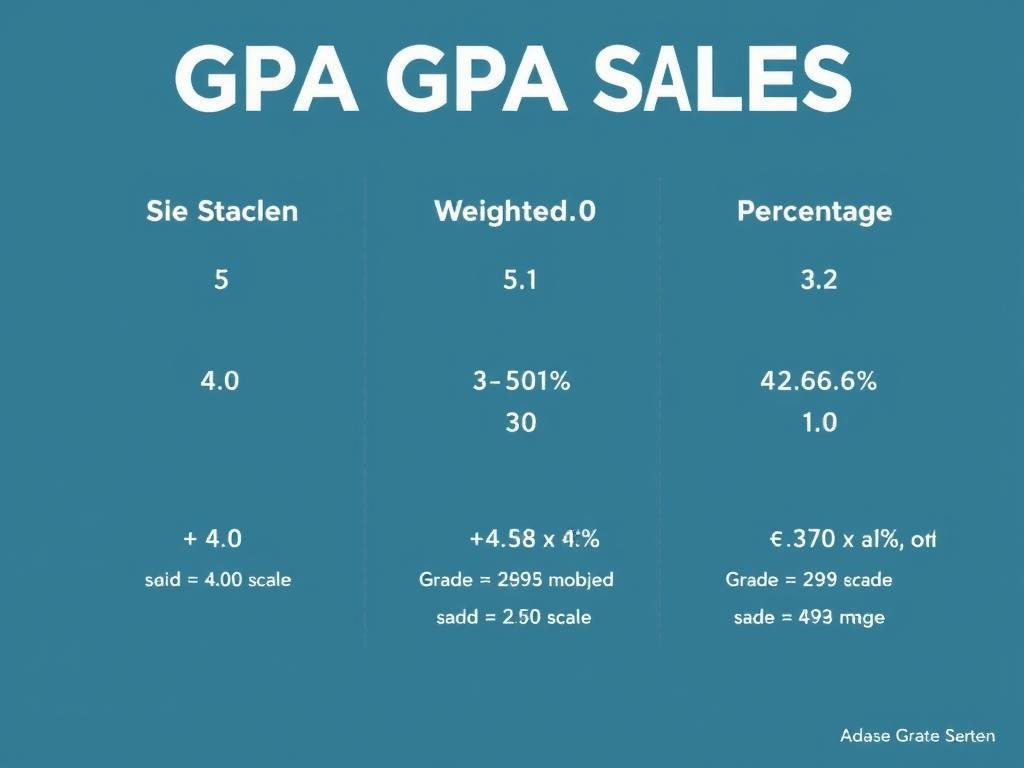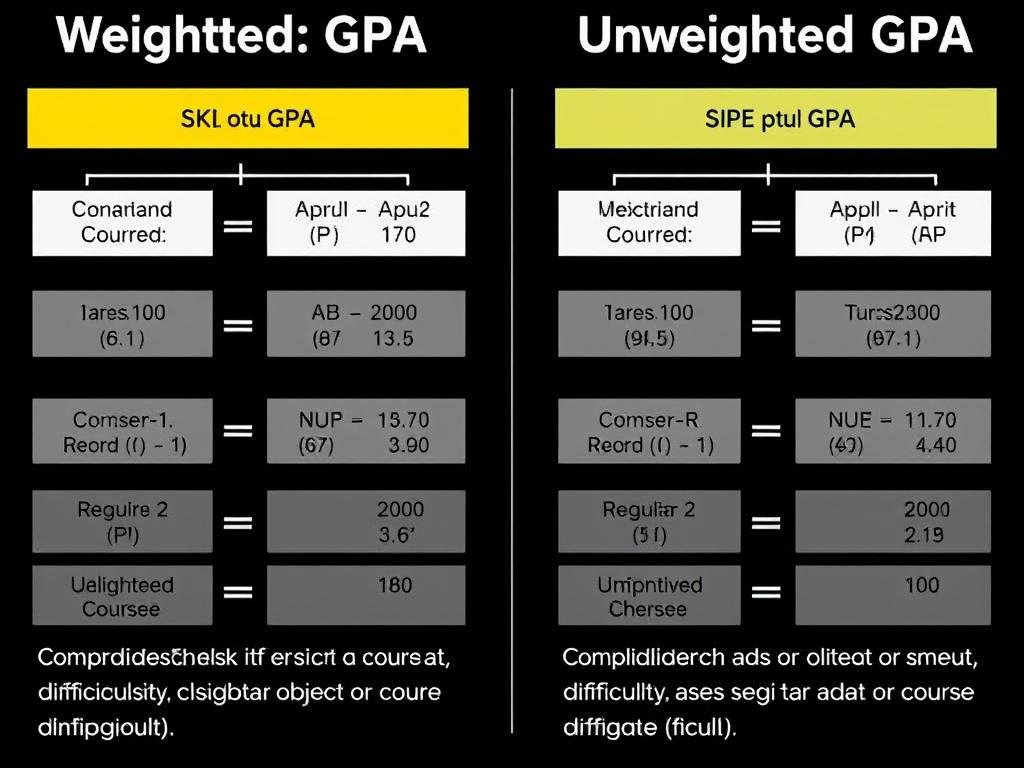Quickly calculate your GPA with our easy-to-use GPA Calculator. Track your academic progress and see what grades you need for your target GPA.
GPA Calculator
4.0 GPA Scale Reference
| Letter Grade | Percentage | GPA Points |
|---|---|---|
| A | 93-100% | 4.0 |
| A- | 90-92% | 3.7 |
| B+ | 87-89% | 3.3 |
| B | 83-86% | 3.0 |
| B- | 80-82% | 2.7 |
| C+ | 77-79% | 2.3 |
| C | 73-76% | 2.0 |
| C- | 70-72% | 1.7 |
| D+ | 67-69% | 1.3 |
| D | 63-66% | 1.0 |
| F | 0-62% | 0.0 |
Grade Point Average (GPA) is a standardized measurement of academic achievement used by schools and universities across the United States. Whether you’re applying for scholarships, planning for graduate school, or simply tracking your academic progress, understanding and calculating your GPA is essential. This comprehensive guide explains everything you need to know about GPA calculation and provides the tools to accurately determine your current standing.
Ready to Calculate Your GPA?
Skip the manual calculations and get instant results with our easy-to-use tool.
What is GPA and Why Does It Matter?

Grade Point Average (GPA) is a numerical representation of your academic performance, typically on a 4.0 scale in the United States. It’s calculated by converting letter grades to points, multiplying by credit hours, and dividing by total credits attempted. Your GPA serves as a standardized way for schools, employers, and scholarship committees to evaluate your academic achievements.
A strong GPA can open doors to numerous opportunities including:
Academic Opportunities
- Honors program eligibility
- Dean’s List recognition
- Graduate school admission
- Academic scholarships
Career Advantages
- Competitive internship placement
- First-job opportunities
- Higher starting salaries
- Professional certification eligibility
Understanding how to calculate and track your GPA allows you to set realistic academic goals and make informed decisions about your course load and study habits.
Understanding Different GPA Scales
Schools across the United States use various GPA scales, though the 4.0 scale remains the most common. Knowing which scale your institution uses is crucial for accurate calculations.

Standard 4.0 Scale (Unweighted)
| Letter Grade | Percentage | Grade Points |
| A+ | 97-100% | 4.0 |
| A | 93-96% | 4.0 |
| A- | 90-92% | 3.7 |
| B+ | 87-89% | 3.3 |
| B | 83-86% | 3.0 |
| B- | 80-82% | 2.7 |
| C+ | 77-79% | 2.3 |
| C | 73-76% | 2.0 |
| C- | 70-72% | 1.7 |
| D+ | 67-69% | 1.3 |
| D | 63-66% | 1.0 |
| F | Below 60% | 0.0 |
Weighted 5.0 Scale
Many high schools use a weighted scale that awards extra points for honors, AP, or IB courses:
- Regular courses: Standard 4.0 scale
- Honors courses: +0.5 points (A = 4.5)
- AP/IB courses: +1.0 points (A = 5.0)
Percentage System
Some institutions use a percentage-based system, which is then converted to letter grades or directly to a GPA equivalent.
Not Sure Which Scale Your School Uses?
Our calculator supports multiple GPA scales to ensure accurate results for your specific institution.
How to Calculate GPA: Step-by-Step Guide

Calculating your GPA manually involves a simple formula, but requires careful tracking of grades and credit hours. Follow these steps for an accurate calculation:
The GPA Formula
GPA = Total Quality Points ÷ Total Credit Hours
Where Quality Points = Grade Points × Credit Hours for each course
Step 1: Assign Point Values to Letter Grades
Convert each letter grade to its numerical equivalent using your school’s scale. On the standard 4.0 scale:
- A = 4.0 points
- B = 3.0 points
- C = 2.0 points
- D = 1.0 points
- F = 0.0 points
Step 2: Multiply Grade Points by Credit Hours
For each course, multiply the grade points by the number of credit hours to get quality points.
Step 3: Add Up All Quality Points
Sum the quality points from all courses.
Step 4: Divide by Total Credit Hours
Divide the total quality points by the total number of credit hours attempted.
Example Calculation
| Course | Grade | Grade Points | Credit Hours | Quality Points |
| Biology | A | 4.0 | 4 | 16.0 |
| English | B+ | 3.3 | 3 | 9.9 |
| History | A- | 3.7 | 3 | 11.1 |
| Math | C+ | 2.3 | 4 | 9.2 |
| Total | – | – | 14 | 46.2 |
GPA Calculation: 46.2 ÷ 14 = 3.30 GPA
Different Types of GPA Calculations
Depending on your academic needs, you may need to calculate different types of GPAs:
Semester GPA vs. Cumulative GPA
Semester GPA
Measures academic performance in a single term only. Useful for tracking term-to-term progress and setting short-term goals.
Formula: Same as regular GPA but only includes courses from the current semester.
Cumulative GPA
Represents your overall academic performance across all terms. This is typically what appears on your official transcript and what most institutions consider.
Formula: Total quality points from all terms ÷ Total credit hours from all terms.
Weighted vs. Unweighted GPA

Unweighted GPA
Uses the standard 4.0 scale regardless of course difficulty. An A in any class is worth 4.0 points.
Provides a straightforward measure of performance across all courses.
Weighted GPA
Accounts for course difficulty by assigning extra points for honors, AP, or IB courses.
Rewards students for challenging themselves with more difficult coursework.
Major GPA
Some programs focus on your performance in major-specific courses rather than all courses. This calculation includes only courses within your declared major.
Calculate Any Type of GPA
Our calculator supports semester, cumulative, weighted, and unweighted calculations.
The Importance of GPA for Academic and Career Success

Your GPA is more than just a number—it’s a key that can unlock numerous opportunities throughout your academic and professional journey.
Academic Opportunities
- Scholarships and Financial Aid: Many scholarships require minimum GPA thresholds, typically 3.0 or higher.
- Graduate School Admission: Most graduate programs have GPA requirements ranging from 3.0 to 3.5.
- Academic Honors: Dean’s List and Latin honors (cum laude, magna cum laude, summa cum laude) are awarded based on GPA.
- Study Abroad: Many programs require a minimum GPA (often 2.5 or higher) for eligibility.
Career Implications
- First Job Opportunities: Many employers use GPA as a screening tool for entry-level positions.
- Internship Placement: Competitive internships often require minimum GPAs of 3.0 or higher.
- Professional Certifications: Some certifications consider academic performance as part of eligibility.
- Long-term Earning Potential: Research suggests a correlation between higher GPAs and higher starting salaries.
Did you know? According to the National Association of Colleges and Employers, the average GPA of new graduates hired by companies is 3.2.
Know Where You Stand
Calculate your current GPA to see if you’re on track for your academic and career goals.
Tips for Improving and Maintaining Your GPA

Whether you’re looking to raise a low GPA or maintain a strong one, these strategies can help you achieve your academic goals:
For Raising a Low GPA
Short-term Strategies
- Focus on high-credit courses where improvement will have the biggest impact
- Consider retaking courses with poor grades if your school allows grade replacement
- Take advantage of pass/fail options for electives when appropriate
- Seek tutoring or additional help for challenging subjects
Long-term Approaches
- Develop better study habits and time management skills
- Balance your course load (mix challenging courses with more manageable ones)
- Attend all classes and actively participate
- Form study groups with motivated peers
For Maintaining a Strong GPA
- Stay consistent: Maintain the same study habits that led to your success
- Plan strategically: Choose courses and professors that align with your learning style
- Seek balance: Avoid burnout by managing your course load and extracurricular activities
- Use resources: Take advantage of office hours, study centers, and academic support services
- Track your progress: Regularly calculate your GPA to ensure you’re staying on target

Plan Your GPA Improvement
Calculate what grades you need in upcoming courses to reach your target GPA.
Frequently Asked Questions About GPA

Do pass/fail classes affect my GPA?
Typically, courses taken as pass/fail do not impact your GPA. A passing grade provides credit toward graduation requirements without affecting your GPA, while a failing grade counts as 0.0 and will lower your GPA. Check your school’s specific policy, as some institutions have unique rules for pass/fail courses.
How do withdrawals affect my GPA?
A standard withdrawal (W) usually doesn’t affect your GPA, though it will appear on your transcript. However, a withdrawal-fail (WF) typically counts as an F (0.0) in GPA calculations. Always check withdrawal deadlines and policies at your institution.
What’s considered a good GPA?
Generally, a GPA of 3.0-3.5 is considered good, 3.5-3.8 is very good, and 3.8-4.0 is excellent. However, standards vary by institution, program, and purpose. For graduate school admission, competitive programs often look for 3.5+, while many scholarships require 3.0+.
Do all classes count toward GPA?
Most credit-bearing courses with letter grades count toward GPA. However, some exceptions may include transfer credits, pass/fail courses, audited courses, and remedial courses. Check your school’s academic policy for specific information.
Can I round up my GPA?
For informal purposes, rounding to the nearest tenth (e.g., 3.45 to 3.5) is common. However, for official transcripts and applications, most institutions report exact GPAs to two decimal places without rounding. Never round a GPA from one whole number to another (e.g., 2.95 to 3.0).
How do I convert percentage grades to GPA?
First, convert percentages to letter grades using your school’s grading scale, then convert those letters to GPA points. For example, if 90-100% = A (4.0), 80-89% = B (3.0), etc., a grade of 85% would convert to a B (3.0) on the GPA scale.
Have More Questions?
Our calculator includes detailed explanations and handles special cases like pass/fail courses.
Start Calculating Your GPA Today

Understanding your GPA is a crucial step in taking control of your academic journey. Whether you’re aiming for scholarships, graduate school admission, or simply tracking your progress, our GPA calculator provides the accurate information you need to make informed decisions.
Don’t leave your academic standing to guesswork. Use our free GPA calculator to:
- Calculate your current semester or cumulative GPA
- Determine what grades you need to achieve your target GPA
- Track your progress over multiple semesters
- Plan your course selection strategy
Take the First Step Toward Academic Success
Our user-friendly calculator makes it easy to understand where you stand and what you need to achieve your goals.